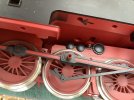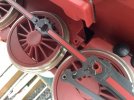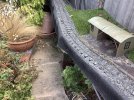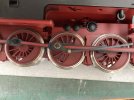Will look at your 64 then answer the first part in an edit to this post. If I am able.Many Thanks Jon this is all really helpful.
I'm still debating where to apply the razor saw to my Bubikopf - cab or side tanks? - to house the batteries, see separate thread Piko BR 64 Bubikopf.
When it come to re-assembly, there are three screws with big red washers to attach the chassis to the motor blocks on both Piko locos. But I fear I didn't record how tight they all were and now can't remember! Perhaps all three tight then back off half a turn or all tight and back off the main pivot a whole turn? What would you say?
Edit having read your piece on the 64 again I am in difficulty trying to advise. I would like to see some pictures of the inside of the 64 before commenting. However you do talk about removing the weight and holding stanchions. On relooking at the 95 I could have removed the top of the weight to the depth of the Stanchions mounting a long thin battery pack on top of the space created. I wonder if a similar process coild be appled to the 64? Without any pictures I am just guessing here.
As for the screws, on the 95 they are to allow the chassisi to pivot so some slack is very necessary. Also again on the 95 there are springs that keep things all in place with the centre one having 2 washwes one above the pivit point one below with the spring below that. If your 64 pivots in a y way I would do so that these is a fair bit of play, doing full tight then loosening may not be the best practice as you may damage the plastic inside where the screw screws. I would have thought that a piece of 20 thou plasticard would give a good final resting point if you offer a piece, screw up then withdrawing the plasticard after.
Last edited:




















